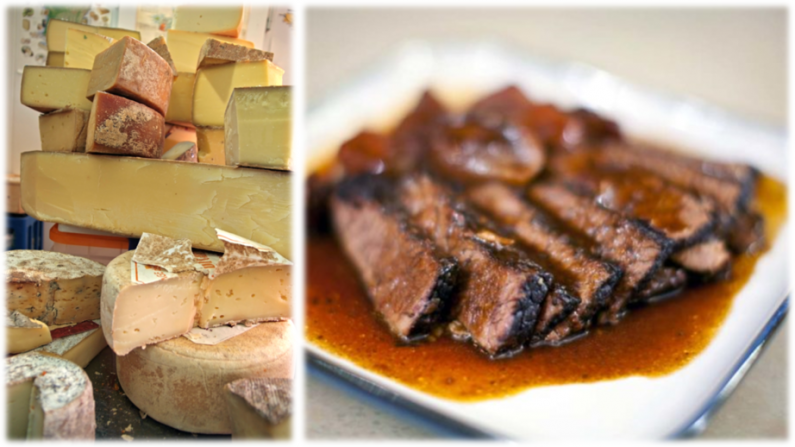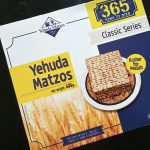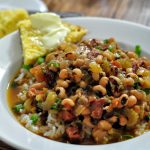What are the Jewish Foods classically connected with Chanukkah (or Hanukkah, Chanuka, Hanuka, etc., choose your spelling…)? Most people would point to latkes or sufganiyot (potato pancakes or jelly doughnuts), or any of many other fried items from around the Jewish world, as the “traditional foods” for this holiday. And while I will not complain about fried yumminess (most things taste better when fried, don’t they?), what I find even more interesting are the numerous other dishes, or categories of foods that have been “traditional” for this holiday at other times and places in Jewish history. And perhaps most fascinating are the sources for many of these culinary customs!
First, however, a brief look at the idea of eating oily foods for the holiday. The practice traditionally is connected with the “miracle of the oil” that the Talmud recounts as taking place on the original Chanukkah: enough oil to supply the Menorah (candelabrum) in the Holy Temple for a single day amazingly lasted for a full eight days, enough time for a new supply to be brought in. The very idea of this food custom encompassing a whole category of foods rather than specific dishes or ingredients highlights the contrast between a holiday such as Chanukkah and one such as Passover. No Jewish holiday has more significant foods that are universally consumed than the latter. Matzoh is mandated by the Torah, as is the bitter herbs and the paschal lamb that had been eaten for the holiday until the destruction of the Temple in the first century C.E. Other foods such as charoset and the four cups of wine came about through the intervention of early rabbis.
Chanukkah, in contrast, is a post-Biblical holiday, and was even viewed with mixed feelings by the sages. (One indication of this hesitance towards the holiday is that it is barely mentioned in the Talmud, in contrast to others such as Passover, Sukkot and Purim that received their own tractates dedicated to their observance.) Thus, there are no foods that we are actually commanded to eat on the holiday. Thus, all of the food traditions we know of on this holiday actually grew entirely out of folk practice. As with many of the customary symbolic foods of Rosh Hashana, Jews everywhere wanted to elevate the foods they ate by choosing ones that represented the meaning of the holiday.
But foods connected with the miraculous oil drew on just one source of inspiration.
As Cheesy As Shavuot
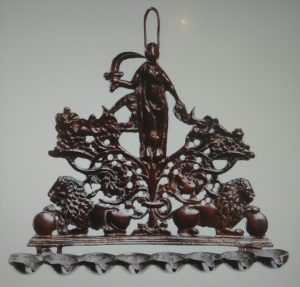
Yes, according to the apocryphal Jewish book of Judith, the titular heroine helped the Jews overcome their enemies by feeding the leader Holofernes cheese. This made him thirsty, so he drank wine, fell asleep and she decapitated him with his own sword! Thus, we should eat cheese (and other dairy foods) on Chanukkah to commemorate this clever victory.
The only problem? Holofernes was not a Greek (despite his name sounding as such). He was an Assyrian, the Jews’ enemies from about a half a millennium earlier! Now, it is certainly seen by scholars, due to various chronological and factual problems in the text, as being an ahistorical book, or at least an inaccurate one. But still, how did the story get glommed onto the holiday of Chanukkah, and thus influence its food?
The book may have been composed shortly after the Macabbean revolt, and some have sought in it a parable to various events of the times. We do know of other books with similar allegorical relations to the events of the time.
Still, there is no overt connection between the Book of Judith and the holiday of Chanukkah, so the idea of consuming dairy foods to connect to this element of the holiday seems at least somewhat off base. But indeed this highlights the folk religion aspect that takes over in the absence of hardcore directives for the festival.
In fact, some of the dairy foods consumed actually fuse this custom with the previously mentioned one of frying things. The original latkes were not made of potatoes but of ricotta cheese, and originated among Sephardic Sicilian Jews who were expelled and brought the dish to northern Italy. From there they eventually worked their way upwards into the bulk of Central and Eastern Europe.(1)Gil Marks, Encyclopedia of Jewish Food Another food that today is more frequently associated with Shavuot but used to be eaten frequently on Chanukkah was the cheese blintz. Again, combining the twin customs of fried food and dairy, it was seen as perfect for this pre-winter holiday.
The Meaty Side
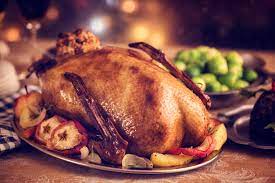
Up until the very modern and contemporary times, animals were frequently slaughtered before the winter, since they would cost a lot to feed during the cold, snow-covered months. Only those animals that were to be kept alive for future breeding or labor purposes made it past December. So there was typically a temporary surplus in meat at the time. In Eastern Europe, typically poorer Jews couldn’t afford to eat the entire meat supply of a single cow (not even the entire front half, since the rear half was forbidden to them). They would sell the more valuable portions, thus gaining money to recoup their initial investment, and only ate the cheap cuts themselves. Brisket was one such meat that was left for the poor owner of the slaughtered animal.
In western Europe, particularly around Alsace, goose were also slaughtered at this time, but not only to save on feed through the winter months. Also because geese provided the main cooking fat — schmaltz — used by the Jews in that area. Schmaltz in Eastern Europe more commonly came from chickens, and they were typically kept alive through the winter for their daily egg production. But those Jews of the west who raised geese needed to stock up on schmaltz for the winter (and even for the upcoming Passover). And of course that also provided them with the medium for frying up their latkes!
So in these cases, the “traditional” Chanukkah foods had virtually nothing to do with the holiday itself, just the ingredients that were available at that time of year.
Drawing on Other Sources

Regardless which is correct, it appears that this classic non-Jewish pastry was applied to Chanukkah consumption not only because it was fried, but because Christians used it to celebrate their religious holidays. The other half of the sufganiyah story is even less connected to our holiday. According to Jewish food historian Gil Marks, it was in the 1920s in Israel that the Histadrut labor union began pushing the jelly doughnuts over potato latkes (levivot, as they are called in Hebrew) as a preferable Chanukkah fried food. For one main reason: latkes could easily be cooked at home, but doughnuts were typically made by professional bakers, thus providing work and jobs for many union laborers!
The sufganiyah is not the only traditional fried Chanukkah food that draws on a non-Jewish root. Cochini Indian Jews eat a fritter called neyyappam, made from local ingredients such as rice, bananas and cardamom. The very same food is considered “an ancient specialty” by the Hindus of the area, who offer it in their temples during their holiday celebrations!(4)Dr. Essie Sassoon, Bala Menon and Kenny Salem, Spice and Kosher
A further example — less religious in nature, but still connected somewhat to non-Jews — may be found in the Greek city of Ionnina. The fried whole wheat Chanukkah pancakes the Romaniote Jews there eat is common to many other communities of the region, but they give it a special name: lalangites rather than the typical tiganites. The name there stems from a beloved Christian merchant who sold them in that city and was constantly mobbed by the local Jewish children.(5)Nicholas Stavroulakis, Cookbook of the Jews of Greece This areligious source may stem from the unique nature of this Jewish community. As Greek-Jewish food scholar Nicholas Stavroulakis has written, Chanukkah was not a super popular holiday in Greece for much of history, which may stem from the origins of the community there. He says the earliest Jewish communities there may have been founded by Hellenized Jews who returned with the defeated Greeks following the events of the Chanukkah story. They clearly would have been less gung-ho about celebrating this holiday.
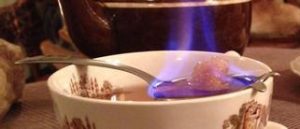
This ceremony clearly connects to the miracle of the oil, and the idea of Chanukkah being a Festival of Lights. But even this may start in non-Jewish sources. Since the first mention of this miracle in any written source appears only hundreds of years after the events of Chanukkah, many consider them ahistorical, and a rabbinic invention. The idea of a festival of light around this time is common to many pagan religions, as the days turn from short to increasingly long. Thus, therefore may have been the source for the rabbi’s idea of a miracle at this time connected to oil and fire.
I, however, would like to suggest a different reason the rabbis may have inserted this “miracle” into the lore of the holiday. I believe it less about both the generic celebration of light at this time or their discomfort with the holiday itself, and more about the loss of its original cause for celebration. To my view, the essence of Chanukkah originally was a celebration of the reestablishment of Jewish self-rule in the land of Israel, after several hundred years of foreign power. It was the original Yom HaAtzmaut! But once we’d again lost that self-rule, and even moreso after the Temple was destroyed, how could we continue to celebrate this holiday? So they infused the holiday with a new meaning, the meaning that is the very purpose of our having self-rule. The book of Isaiah indicates the role of the Jewish people as a “light unto the nations.”
So in general, we see many “traditional” foods for Chanukkah that have sources barely tied to the holiday itself, and some even questionably or definitely not tied at all. And yet, that may highlight the very essence of the holiday itself. We connect with the people around, take from them and give back, ideally in improved and influential ways. Folk wisdom should not be seen as second-rate in comparison to direct Torah commandments. Rather the customs that grow out of our people’s general practices supplements and complements the traditions that are more directly tied to religious observance. In this way, Jews infuse their entire lives with Judaism and its values.
And since we are now, once again, controllers of our own destiny in our ancient homeland, perhaps we can create a new food tradition that connects with the original (Yom HaAtzmaut) meaning of the day, while also recognizing the traditions being brought back here with those Jews who have returned form the four corners of the Earth. I suggest Milk and Honey Fritters: cheese latkes made using goat or sheep’s milk cheese and drizzled with silan (date honey)!

